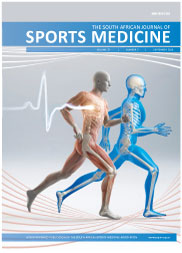Junior cricketers are not a smaller version of adult cricketers: A 5-year investigation of injuries in elite junior cricketers
DOI:
https://doi.org/10.7196/SAJSM.543Abstract
Background. Injury surveillance is fundamental to preventing and reducing the risk of injury. Objectives. To determine the incidence of injuries and the injury demographics of elite schoolboy cricketers over five seasons (2007 - 2008, 2008 - 2009, 2009 - 2010, 2010 - 2011 and 2011 - 2012). Methods. Sixteen provincial age group cricket teams (under (U) 15 , U17 and U18) competing in national age-group tournaments were provided a questionnaire to complete. The questionnaires gathered the following information for each injury sustained in the previous 12 months: (i) anatomical site; (ii) month; (iii) cause; (iv) whether it was a recurrence of an injury from a previous season; (v) whether the injury had reoccurred during the current season; and (vi) biographical data. Injuries were grouped according to the anatomical region injured. All players were invited to respond, irrespective of whether an injury had been sustained, resulting in a response rate of 57%. The sample Statistical Analysis System was used to compute univariate statistics and frequency distributions. Results. Of the 2 081 respondents, 572 (27%) sustained a total of 658 injuries. The U15 and U17 groups sustained 239 (36%) and 230 (35%) injuries, respectively, more than the 189 injuries sustained by the U18 group (29%). These injuries were predominantly to the lower limbs (38%), back and trunk (33%) and upper (26%) limbs, with 3% occurring to the head and neck. The injuries occurred primarily during 1-day matches (30%), practices (29%) and with gradual onset (21%). The primary mechanism of injury was bowling (44%) and fielding (22%). The injuries were acute (49%), chronic (41%) and acute-on-chronic (10%), with 26% and 47% being recurrent injuries from the previous and current seasons, respectively. Some similar injury patterns occurred in studies of adult cricketers, with differences in the nature and incidence of injuries found for the various age groups. The youth cricketers sustained more back and trunk injuries, recurrent injuries and more match injuries than the adult cricketers. The U15 group sustained less-serious injuries, which resulted in them not being able to play for between 1 and 7 days (58%), with more injuries occurring in the preseason period (24%) and fewer during the season (60%) compared with other age groups. The U15 and U17 groups sustained the most lumbar muscle strains, while the U18 groups sustained more serious injuries, resulting in them not being able to play for >21 days. Conclusion. Young fast bowlers of all ages remain at the greatest risk of injury. Differences in the nature and incidence of injuries occurred between youth and adult cricketers, as well as in the different age groups. It is recommended that cricket administrators and coaches implement an educational process of injury prevention and managementDownloads
Downloads
Published
2014-12-15
Issue
Section
Articles
License
Copyright (c) 2014 South African Journal of Sports Medicine

This work is licensed under a Creative Commons Attribution 4.0 International License.
The South African Journal of Sports Medicine reserves copyright of the material published. The work is licensed under a Creative Commons Attribution 4.0 (CC BY 4.0) International License. Material submitted for publication in the South African Journal of Sports Medicine is accepted provided it has not been published elsewhere. The South African Journal of Sports Medicine does not hold itself responsible for statements made by the authors.
How to Cite
Stretch, R. (2014). Junior cricketers are not a smaller version of adult cricketers: A 5-year investigation of injuries in elite junior cricketers. South African Journal of Sports Medicine, 26(4), 123-127. https://doi.org/10.7196/SAJSM.543
Views
- Abstract 644
- PDF 574
Metrics

- Citations
- Citation Indexes: 16
- Usage
- Full Text Views: 1694
- Abstract Views: 309
- Captures
- Readers: 29





.png)